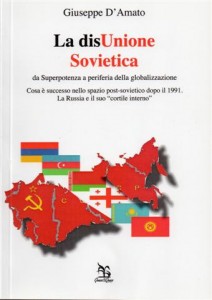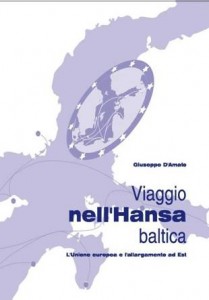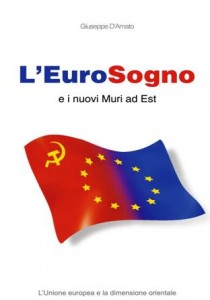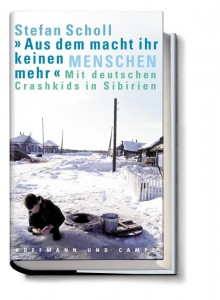Turning points: Syria and the Russian diplomacy. Stalingrad syndrome.
“Damascus is the “Stalingrad” of Russian diplomacy. After years of geopolitical withdrawal, Moscow has chosen Syria as a way to revive its image of power in the world. “Not one step back” is the Kremlin’s new strategy, as it was for the Red Army along the banks of the Volga river during World War II. To be more convincing, the Kremlin has simultaneously flexed its muscles by supplying sophisticated […]
Только модернизация спасет Россию!
22 Nov 2010«Европа, точнее, старая Европа, подыхает. Потихонечку, но обязательно. Я узнал об этом впервые, будучи студентом и владея русским языком уже достаточно хорошо, чтобы читать “Правду” и другие советские газеты…
И все-таки Европу уже никто не спасет. Во всяком случае так говорят мои нынешние русские знакомые, которые не раз совершали туры в Шенгенскую зону. Говорят, что вслед за Советским Союзом старуха-Европа переживает предсмертный застой. Беззубая прабабушка болеет — и слишком большим терпением к секс-меньшинствам, и слишком педантичной политкорректностью… Бюргерам, короче, скоро капут…
Давайте посмотрим на этот бюргерский беспредел русскими глазами…»
–
Штефан Шолль статья Московский Комсомолец № 25500 от 16 ноября 2010 г.
Stefan Scholl Moskovskij Komsomolets
Primi passi concreti verso un mondo più sicuro. Gli ex nemici della Guerra Fredda iniziano seriamente a collaborare tra loro. L’intesa politica tra Nato e Russia si appoggia principalmente su due elementi: sviluppo comune di un mini-Scudo regionale; aiuto nel disinnescare la mina afghana.
Ma prima la nuova Concezione strategica della Nato la cui definizione – come ha candidamente ammesso in conferenza stampa a Lisbona il presidente Medvedev – Mosca ha seguito nei mesi scorsi con estrema “attenzione”. Nel documento si legge che l’Alleanza atlantica “non rappresenta una minaccia per la Russia”, anzi “cerca con lei cooperazione”. Questa collaborazione è “strategicamente importante, poiché contribuisce alla creazione di un comune spazio di pace, stabilità e sicurezza”.
Il capo del Cremlino ha dichiarato che complessivamente nella Concezione strategica della Nato si esprimono bene i nuovi rapporti con il suo Paese. La speranza russa è che questo momento positivo nelle relazioni Est – Ovest non sia un semplice “venticello” passeggero come già avvenuto in altre occasioni in passato.
Ecco perché Mosca ha accettato le offerte occidentali di cooperazione, ma non si fida più di tanto. La principale preoccupazione è rappresentata dalla complessa ratifica dello Start da parte del Senato Usa. “Faremo le cose in maniera simmetrica”, ha ammonito Medvedev, che ha sottolineato come il mancato voto favorevole al trattato dei parlamentari statunitense “non renderà il mondo più sicuro”.
Veniamo al mini-Scudo. Ormai non si parla più, come ai tempi di Bush, di Scudo spaziale strategico, quello per intenderci contro i vettori a lungo raggio, ma di difese anti-missilistiche regionali contro minacce portate da piccola e media distanza. La Nato ha inviato a Mosca, alcune settimane fa, i suoi esperti per definire tecnicamente come unire il proprio sistema con quello russo. Nei prossimi mesi il lavoro proseguirà con ufficialmente la benedizione del duo Medvedev-Putin.
Le cose non vanno troppo bene in Afghanistan, dove, da anni, la Nato sta levando le castagne dal fuoco alle repubbliche ex sovietiche. Anche durante le settimane più oscure della crisi tra Bush ed il Cremlino la Russia non ha mai cancellato il permesso di transito di materiale logistico alleato verso l’Asia centrale.
Invero Mosca da quelle terre sfortunate non ha mai distolto l’attenzione. Ad iniziare dall’autunno ’96 dopo che i talebani presero il potere a Kabul. Il Cremlino convocò una riunione d’emergenza delle repubbliche ex Urss asiatiche per organizzare la difesa dello spazio ex sovietico. I successivi attacchi islamici in Tagikistan, Kirghizistan ed Uzbekistan e le infiltrazioni in Caucaso settentrionale le diedero ragione.
Adesso che è stata annunciato l’inizio di una “exit-strategy” dall’Afghanistan dal 2011 al 2014 la preoccupazione nell’ex Urss torna a salire. Una voce, che si rincorre, è che qualcuno in Occidente pensi addirittura di ripassare il boccone avvelenato afghano al Cremlino. Medvedev ha ricordato come la situazione interna di quel Paese “rappresenta una minaccia per il mondo circostante”.
Tornando a Lisbona, dove è stata a più riprese utilizzata la parola “partner”, i russi hanno concesso ufficialmente maggiore libertà di transito per il rientro delle truppe Nato tra il 2011 ed il 2014. Ma gli occidentali si aspettano un ruolo molto più attivo del Cremlino.
Certo è che se la Russia vorrà rimanere una potenza regionale dovrà fare la sua parte anche nei teatri scomodi. Il problema è se l’ex superpotenza ha dentro di sé la forza morale e materiale per un tale compito.
Giuseppe D’Amato
NATO Strategic Concept.
US President Barack Obama: the agreement “responds to the threats of our times”.
“For the first time, we have agreed to develop a missile defence capability that’s strong enough to cover all NATO European territory and populations, as well as the United States.”
The document commits NATO members “to defend one another against attack, including against new threats to the safety of our citizens”, without defining a geographical limit to its theatre of operations. The alliance would also seek to “create the conditions” for a world without nuclear weapons, but until that goal was in sight would remain a nuclear-armed organisation.
Polish President Bronislaw Komorowski called the new NATO strategic concept as “satisfactory for Poland”.
Russia.
German Chancellor Angela Merkel: “A former military adversary is now clearly a partner.”
US President Barack Obama: “We look forward to working with Russia to build our cooperation with them in this area (anti-missile Shield) as well recognizing that we share many of the same threats.”
Ratification of the new START weapons treaty.
Obama: “Those who would block this treaty are breaking President Reagan’s rule — they want to trust, but not verify.”
* * *
From the NEW official NATO Strategic Concept. – NATO and RUSSIA –
* PAGE 5. We will actively seek cooperation on missile defence with Russia and other Euro-Atlantic partners;
* PAGE 7-8. In any future reductions, our aim should be to seek Russian agreement to increase transparency on its nuclear weapons in Europe and relocate these weapons away from the territory of NATO members. Any further steps must take into account the disparity with the greater Russian stockpiles of short-range nuclear weapons.
* PAGE 10 – POINT 33 NATO-Russia cooperation is of strategic importance as it contributes to
creating a common space of peace, stability and security. NATO poses no threat to Russia. On the contrary: we want to see a true strategic partnership between NATO and Russia, and we will act accordingly, with the expectation of reciprocity from Russia.
* PAGE 10 – POINT 34 The NATO-Russia relationship is based upon the goals, principles and
commitments of the NATO-Russia Founding Act and the Rome Declaration, especially regarding the respect of democratic principles and the sovereignty, independence and territorial integrity of all states in the Euro-Atlantic area. Notwithstanding differences on particular issues, we remain convinced that the security of NATO and Russia is intertwined and that a strong and constructive partnership based on mutual confidence, transparency and predictability can best serve our security. We are determined to:
• enhance the political consultations and practical cooperation with Russia in areas of shared interests, including missile defence, counter-terrorism, counter-narcotics, counter-piracy and the promotion of wider international security;
• use the full potential of the NATO-Russia Council for dialogue and joint action with Russia.
Каспийский регион: море проблем.
19 Nov 2010«Главной темой саммита прикасписйских стран стала безопасность. Именно от решения вопросов, связанных с безопасностью, зависит решение самой главной проблемы в “каспийской повестке” – определении политико-правового статуса Каспийского моря...
…Для политиков, дипломатов и экспертов Каспийское море давно уже представляет собой настоящий океан проблем, где безбрежные горизонты сотрудничества соседствуют с не менее безбрежными горизонтами проблем….
…Среди тревожных тенденций, которые сегодня наблюдаются, следует назвать процесс дальнейшей милитаризации Каспийского моря, проблему сохранения биоразнообразия Каспия, малорезультативность борьбы с браконьерством, высокие риски возникновения в регионе экологических катастроф.
…ситуация на Севере Каспия и на Юге значительно отличается. Отличительной чертой Северного участка Каспия является то, что Азербайджану, Казахстану и России удалось договориться на юридической основе о принципах взаимодействия. В 2003 году они подписали соглашение о точке стыка линий разграничения сопредельных участков дна Каспийского моря. Документ на уровне заместителей министров иностранных дел узаконил (в трехстороннем формате) правовой статус около 60% недр акватории моря. А вот на Юге развитие диалога упирается, главным образом, в позицию Ирана, выступающего за равнодолевое разделение Каспийского моря.
..Каспий, являющийся крупным геополитическим узлом, вызывает оживленный интерес европейских стран, Турции и США. Есть мнения, что внедрение в регион этих крупнейших игроков будет препятствовать распределению ресурсов и разделу Каспийского моря….
..Сегодня задачей, в первую очередь, таких стран как Азербайджан, Казахстан и Туркменистан является оптимизация присутствия внешних, в том числе и политических игроков в Каспийском регионе. Сделать так, чтобы их присутствие не становилось тормозом для развития собственного сотрудничества прикаспийских стран во всех сферах и направлениях».
Мнение – Ильгар Велизаде, политолог (Баку) – РИА Новости.
“Our relationship with our European allies and partners is the cornerstone of our engagement with the world, and a catalyst for global cooperation. With no other region does the United States have such a close alignment of values, interests, capabilities and goals…
As an alliance of democratic nations, NATO ensures our collective defence and helps strengthen young democracies. Europe and the United States are working together to prevent the spread of nuclear weapons, promote peace in the Middle East and confront climate change…
We are each other’s closest partners. Neither Europe nor the United States can confront the challenges of our time without the other…
NATO will also transform itself in Lisbon with a new Strategic Concept that recognizes the capabilities and partners we need to meet the new threats of the 21st century. This must begin by reaffirming the lifeblood of this alliance — our Article 5 commitment that an attack on one is an attack on all…
We can resume practical cooperation between NATO and Russia that benefits both…we can make it clear that NATO sees Russia as a partner, not an adversary. We can deepen our cooperation on Afghanistan, counter-narcotics and 21st century security challenges — from the spread of nuclear weapons to the spread of violent extremism. And by moving ahead with cooperation on missile defense, we can turn a source of past tension into a source of cooperation against a shared threat…”
Full text – Barack Obama – President of the United States – Before Meetings in Lisbon.
«В канун четвертых выборов президента вновь звучат уверения, что ключи от белорусской “президентции” лежат в Кремле. Белорусские избиратели с этим не согласны. И в целом демонстрируют все более проевропейские настроения».
Статья – БДГ Деловая Газета – Валерия Костюгова
About 40% of Russians, or almost 57 million people, drink to excess, a Health Ministry top specialist told Rossiiskaya Gazeta.
Yevgeny Bryun said the number of registered alcohol addicts in the country is about 2%, or 2.7 million people. “I mean the number of people, who are undergoing treatment,” he said in an interview with the government daily. “But all kinds of problems, I mean economic, social and family troubles, come mainly from those who just drink to excess. They constitute about 30-40% of our population.”
Alcohol consumption in Russia per capita is currently about 18 liters a year, twice the critical norm set by the World Health Organization. The Russian government has declared an anti-alcohol campaign and aims to halve consumption by 2020 and root out illegal production and sales.
Bryun also said that around one and a half million people are addicted to heroin in Russia, almost three times as much as the number of registered users. “Some 530 drug addicts are registered, but the total figure stands at 1.5 million, according to our estimates,” the official said.
Many experts believe the real figure to be as high as 2.5 million, accounting for almost 2% of the Russian population. According to official statistics, around 30,000 people die in Russia every year from heroin, around 90% of it coming from Afghanistan. Last year, a total of 825 people died from drug overdoses in Moscow alone, almost twice as many as in 2008.
From Ria Novosti – Rossiiskaya Gazeta
A new expensive energy strategy for Europe.
15 Nov 2010Europe needs a new strategy for energy. The narrow interests of national capitals prevailed too long. EU leaders will be asked to support a plan for unity at the first EU energy summit on February 2011. These are the main points in European Union Energy Commissioner Guenther Oettinger’s programme unveiled in Brussels. According to his remarks the Twenty-seven have to invest 1 trillion euros over the next decade in a shared EU energy network.
The International Energy Agency forecasted global oil supplies would peak around 2035, when oil prices would exceed $200 a barrel, kicking off a scramble for alternative energy sources. “To have an efficient, competitive and low-carbon economy, we have to Europeanize our energy policy and focus on a few, but pressing, priorities,” Oettinger said. The idea of uniting Europe’s infrastructure is not new, nor is that of liberalizing the markets for the gas and electricity that flow through it.
Article – Deutsche Welle – November 2010.
Альтернативные трубы или дефицит?
12 Nov 2010Российская “Транснефть” заявила, что больше не нуждается в нефтепроводах “Одесса-Броды” и “Дружба”. С 2011 года компания сможет прокачивать нефть по альтернативным направлениям за пределами Украины и Белоруссии. По его словам первого вице-президента АК “Транснефть” Михаила Арустамова, Россия активно использовала маршруты “Броды-Одесса” и “Броды-Южный”, когда у нее был недостаток экспортных мощностей. Но в результате введения в эксплуатацию трубопроводной системы “Восточная Сибирь-Тихий океан” этот дефицит резко сократился.
Статья – Коммерсант Украйна 11.11.2010 г.
От Коммерсанта
«Магистральный нефтепровод Одесса–Броды построен в 2001 году для транспортировки каспийской нефти. Украина в течение двух лет безуспешно пыталась договориться о транспортировке по нему каспийской нефти в прямом направлении. Не получив предложений со стороны компаний, добывающих нефть в Казахстане, Кабмин в конце июня 2004 года разрешил использовать трубопровод для транспортировки российской нефти в реверсном режиме. Мощность трубопровода составляет 9 млн т.»
Poland. Smolensk cross at Saint Anne’s.
12 Nov 2010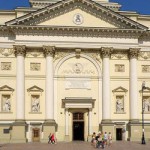 The Smolensk cross has been relocated this week from the Presidential Palace chapel to the nearby St Anne’s church. The move puts an end to a long controversial row. The Catholic Church had accused Poland’s politicians of politicizing the matter.
The Smolensk cross has been relocated this week from the Presidential Palace chapel to the nearby St Anne’s church. The move puts an end to a long controversial row. The Catholic Church had accused Poland’s politicians of politicizing the matter.
The cross was the centerpiece of a conflict between supporters of the Law and Justice party (PiS) on one side and President Komorowski, the government and secular politicians on the other over the place of religious symbols in public places. It was erected in April by the Scouts as a symbol of mourning after the death of President Lech Kaczynski, his wife, and 94 others onboard the plane crashed on landing at Smolensk Severny airport in Russia.
Later in summer, the cross was relocated from outside the Presidential Palace to the palace chapel, in a surprise move which angered protestors who wanted the cross to remain where it was. Following the attempt on 3 August to move it further to St. Anne’s church, just down the road, – when police clashed with protestors – it was decided the cross would be taken on a Pilgrimage leaving two days later to the holy shrine of Jasna Gora in the southern city of Czestochowa, also without success.
Groups of elderly Kaczynski supporters kept guard round the clock for several days to prevent its removal, accusing Komorowski, the Prime Minister Tusk and Civic Platform (PO) of betraying Poland and the Catholic faith. A hard-line group, the so-called “Defenders of the Cross“, opposed any decision unless a permanent memorial would have been installed. Some 77% of Poles surveyed by stats researcher GfK Polonia for Rzeczpospolita daily saw the cross relocation to the presidential chapel as the right decision.
According to a joint statement by the President’s Chancellery, Warsaw diocese, a scout organisation “the Academic Church of St Anne in Warsaw, a place strongly bound to the history of … Poland. This temple is the site of permanent prayers for the tragically perished President Lech Kaczynski, his wife and all victims of the Smolensk catastrophe.”
Welcome
We are a group of long experienced European journalists and intellectuals interested in international politics and culture. We would like to exchange our opinion on new Europe and Russia.
Categories
- Breaking News (11)
- CIS (129)
- Climate (2)
- Energy&Economy (115)
- EU Eastern Dimension (85)
- Euro 2012 – Sochi 2014 – World Cup 2018, Sport (43)
- Euro-Integration (135)
- History Culture (198)
- International Policy (261)
- Military (74)
- Interviews (18)
- Italy – Italia – Suisse (47)
- Odd Enough (10)
- Poland and Baltic States (126)
- Religion (31)
- Russia (421)
- Survey (4)
- Turning points (4)
- Ukraine (176)
- Российские страницы (113)
Archives
- November 2020
- October 2020
- September 2020
- August 2020
- July 2020
- May 2020
- April 2020
- March 2020
- January 2020
- December 2019
- November 2019
- October 2019
- September 2019
- August 2019
- July 2019
- June 2019
- May 2019
- April 2019
- March 2019
- February 2019
- December 2018
- November 2018
- October 2018
- September 2018
- August 2018
- July 2018
- June 2018
- May 2018
- April 2018
- March 2018
- February 2018
- January 2018
- December 2017
- November 2017
- October 2017
- September 2017
- August 2017
- July 2017
- May 2017
- March 2017
- January 2017
- December 2016
- November 2016
- October 2016
- September 2016
- July 2016
- June 2016
- May 2016
- April 2016
- February 2016
- January 2016
- November 2015
- October 2015
- September 2015
- June 2015
- April 2015
- March 2015
- February 2015
- January 2015
- December 2014
- November 2014
- October 2014
- September 2014
- August 2014
- July 2014
- June 2014
- May 2014
- April 2014
- March 2014
- February 2014
- January 2014
- December 2013
- November 2013
- October 2013
- September 2013
- August 2013
- July 2013
- June 2013
- May 2013
- April 2013
- March 2013
- February 2013
- January 2013
- December 2012
- November 2012
- October 2012
- September 2012
- August 2012
- July 2012
- June 2012
- May 2012
- April 2012
- March 2012
- February 2012
- January 2012
- December 2011
- November 2011
- October 2011
- September 2011
- August 2011
- July 2011
- June 2011
- May 2011
- April 2011
- March 2011
- February 2011
- January 2011
- December 2010
- November 2010
- October 2010
- September 2010
- August 2010
- July 2010
- June 2010
- May 2010
- April 2010
- March 2010
- February 2010
- January 2010
- December 2009
- November 2009
- October 2009
- September 2009
- August 2009
Our books
